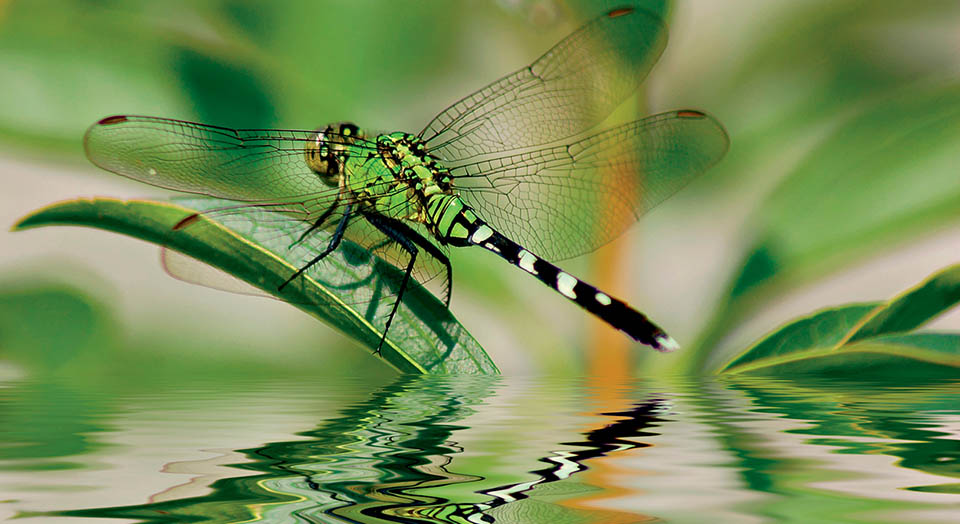Living Lightly
A stepping stone for dragonflies
 ECO-MINDED GARDENERS KNOW to cultivate plants native to their area or flowers that attract pollinators. But backyard ponds for dragonflies and damselflies can further contribute to healthy local ecosystems—and it can be a lot of fun.
ECO-MINDED GARDENERS KNOW to cultivate plants native to their area or flowers that attract pollinators. But backyard ponds for dragonflies and damselflies can further contribute to healthy local ecosystems—and it can be a lot of fun.
Odonates, which encompass about 5,000 species of damselflies and dragonflies, require wetland habitat for laying their eggs and development of the nymphs, but North America has lost an estimated 221 million wetland acres since the arrival of European settlers in the early 1600s.
Between 2004 and 2009 alone the United States lost more than 360,000 acres of wetlands, according to a study conducted by the U.S. Fish and Wildlife Service and the National Oceanic and Atmospheric Administration released in 2013.
Remaining wetlands are becoming isolated and declining in quality. Non-native introduced fish have altered predator-prey relationships. Pollution has also taken its toll, and climate change with its temperature shifts poses an additional threat.
At least 20 percent of odonates in North America are considered at risk, and six damselflies and one dragonfly are listed as endangered under the Endangered Species Act.
“Backyard ponds are a great way to rebuild some of their habitat, especially in urbanized areas,” says Shannon McCauley, assistant biology professor at the University of Toronto. “Like stepping stones, the ponds also provide the connectivity that has been lost.”
In return, gossamer-winged dragonflies and damselflies—shooting around like arrows, flashing their colors—will enrich your life. “There is nothing like watching these gorgeous creatures,” says Celeste Mazzacano, an entomologist and co-author of a guide published by the Migratory Dragonfly Partnership in Portland, Oregon.
We need them for practical reasons, too. Spending time in water and on land during their life cycles, odonates are a vital link between terrestrial and aquatic ecosystems. And their sensitivity to the slightest change in their environment makes them model species for monitoring the effects of climate change and ecosystem degradation, although this trait has made them increasingly vulnerable as well.
Voracious predators of invertebrates, both as nymphs and adults, they use their 360-degree vision to hunt whatever comes by, including larval mosquitoes and biting, flying ones. To fuel the ability to fly up to 30 miles per hour, stop abruptly, make instant turns and fly backward, adults can consume up to 15 percent of their bodyweight in prey daily.
“That’s important because warmer temperatures associated with climate change are likely to speed up development of mosquito larvae and possibly the diseases they carry, so having more of their predators around is good,” says Aimee Delach, a Defenders’ senior policy analyst. “It’s not a stretch to call odonates the wolves of the insect world.”
In fact, around a well-constructed pond, mosquitoes are not likely to be a problem, especially once your ecosystem has established itself. Your visiting odonates may draw hungry birds, bats, lizards and frogs. Hawks may show up, perhaps a small thirsty fox. In this serene equilibrium, your garden becomes a wildlife oasis.
–Sophia V. Schweitzer
Damselfly or Dragonfly?
Dragonflies hold their wings at right angles when perched, while damselflies fold their wings behind them.
Creating a Healthy pond
-
A pond should have shallow and deeper water zones and a diversity of plant species, some submerged, others floating or emerging from the surface.
-
A minimum of 43 square feet in a sunny location is best, but even a smaller pond can provide a beneficial spot for creatures to rest, mate and feed.
-
Incorporate an outlet for water overflow.
-
Establish a regular cleaning schedule and refill the pond when water levels drop.
-
Plant grasses, sedges and colorful flowers around the edge. The greatest numbers of dragonfly and damselfly species are found at sites with a variety of microhabitats.
-
Add rocks or logs so nymphs have a solid perch to emerge as adults.
-
Mostly, enjoy!
Only select articles from Defenders are available online. To receive 4 issues annually of the full award-winning magazine, become a member of Defenders of Wildlife!

